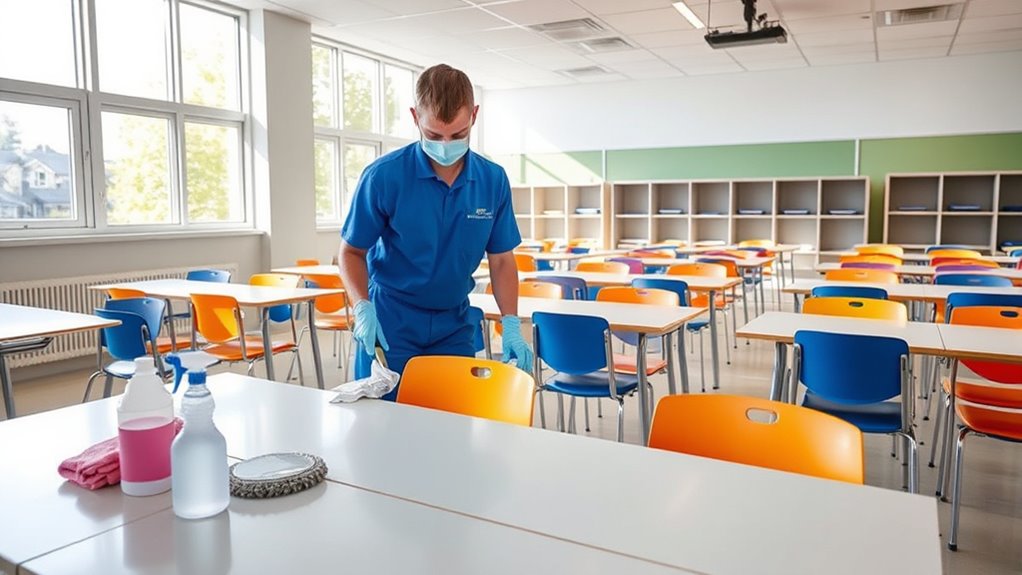To keep your classroom safe and sanitized, develop a consistent cleaning schedule that covers daily, weekly, and monthly tasks. Focus on disinfecting high-touch areas like desks, doorknobs, and switches multiple times daily using EPA-approved disinfectants. Promote good hygiene habits among students, such as regular handwashing and using hand sanitizers. Train staff on proper cleaning techniques and monitor progress regularly. Keep your environment healthy and inviting—continue exploring more tips to enhance your cleaning routine.
Key Takeaways
- Develop a comprehensive cleaning schedule that covers daily, weekly, and monthly tasks for all classroom areas.
- Focus on disinfecting high-touch surfaces like desks, doorknobs, switches, and shared equipment multiple times daily.
- Promote student hygiene through hand sanitizers, regular handwashing, and hygiene education initiatives.
- Train staff on proper cleaning techniques and proper use of EPA-approved disinfectants to ensure safety and effectiveness.
- Regularly monitor and adjust cleaning routines, especially during outbreaks, to maintain a safe and sanitized learning environment.

Have you ever wondered how a clean school environment impacts learning and health? The truth is, maintaining cleanliness isn’t just about appearances; it directly affects student hygiene and overall well-being. When classrooms are consistently clean, students are less likely to fall ill, which means fewer absences and more consistent learning. One key to effective cleaning is establishing clear cleaning schedules. By creating a routine that covers daily, weekly, and monthly tasks, you ensure that every part of the school receives proper attention. Regular schedules prevent the buildup of dirt, germs, and allergens, which can compromise student health. Cleaning schedules should be detailed and adaptable, reflecting the specific needs of each classroom and common areas, so nothing gets overlooked.
Focusing on student hygiene is essential because young learners often touch shared surfaces like desks, doorknobs, and computer equipment. If these surfaces aren’t disinfected regularly, they become breeding grounds for bacteria and viruses. You can encourage good hygiene practices by integrating hand sanitizers at key locations and reminding students to wash their hands frequently. Educating students about personal hygiene also plays a crucial role in maintaining a healthy school environment. Simple habits, like covering coughs and avoiding touching their faces, can markedly reduce the spread of germs.
Encourage handwashing, use hand sanitizers, and teach good hygiene to keep students healthy.
A well-structured cleaning schedule ensures that high-touch areas are disinfected multiple times throughout the day. This includes desks, chairs, light switches, restroom fixtures, and cafeteria tables. It’s important to use appropriate cleaning agents that are effective against germs but safe for children. Additionally, cleaning shouldn’t be limited to just visible dirt; it should target microscopic pathogens that can cause illness. For instance, using EPA-approved disinfectants on surfaces helps eliminate virus particles and bacteria. Incorporating proper cleaning techniques enhances sanitation efforts and ensures safety.
Involving staff in the cleaning process fosters a culture of shared responsibility. Teachers and custodians should be trained on proper cleaning techniques and the importance of maintaining hygiene standards. Furthermore, you should monitor the effectiveness of cleaning schedules regularly, making adjustments as needed, especially during flu seasons or outbreaks. Investing in proper cleaning equipment, like microfiber cloths and HEPA vacuums, can improve efficiency and the quality of sanitation efforts.
Ultimately, a consistent approach to student hygiene combined with well-planned cleaning schedules creates a safer, healthier learning environment. When students see that cleanliness is prioritized, they’re more likely to adopt good hygiene habits themselves. This collective effort helps prevent illness, supports academic success, and fosters a positive school atmosphere where everyone can thrive.
Frequently Asked Questions
How Often Should Classrooms Be Disinfected During Flu Season?
During flu season, you should increase disinfection frequency to prevent the spread of germs. Aim to disinfect high-touch surfaces at least 3-4 times daily, aligning with seasonal cleaning schedules. Regular cleaning helps reduce the risk of infection, so you might also consider daily or more frequent disinfecting depending on classroom activity levels. Staying consistent with these routines keeps your classroom safer and minimizes flu transmission among students and staff.
Are Eco-Friendly Cleaning Products Effective for School Sanitation?
Think of green cleaning as a breath of fresh air, proving it’s effective for school sanitation. You can confidently rely on eco-friendly cleaning products, as they meet rigorous standards and are proven to eliminate germs just as well as traditional options. With proper use, their product effectiveness keeps classrooms safe while protecting the environment. Green cleaning isn’t just good for the planet; it’s a smart choice for maintaining a healthy, sanitized learning space.
What Procedures Are in Place for Cleaning After Student Illnesses?
When cleaning after student illnesses, you follow strict procedures to guarantee safety. You isolate the affected student’s area, removing medical waste properly and disposing of it in designated containers. You disinfect all surfaces thoroughly, paying close attention to high-touch areas. You wear protective gear to prevent cross-contamination, and you ventilate the room to eliminate airborne pathogens. These steps help keep the environment safe for everyone and prevent the spread of illness.
How Can Schools Ensure Proper Training for Cleaning Staff?
You can guarantee proper training for cleaning staff by implementing extensive training programs that cover all sanitation protocols and safety procedures. Encourage staff certifications to validate their skills and knowledge, and provide ongoing education to stay current with best practices. Regularly evaluate and update training materials, and foster a culture of accountability. This approach helps your staff stay well-prepared, confident, and effective in maintaining a clean and safe classroom environment.
What Are the Best Practices for Cleaning Electronic Devices?
Think of electronic devices as delicate snowflakes—you need gentle care to keep them pristine. When cleaning, use a soft cloth dampened with a mixture of 70% isopropyl alcohol for device disinfecting and screen cleaning. Avoid harsh chemicals and spray directly onto screens. Carefully wipe surfaces, paying attention to buttons and ports. This way, you guarantee your devices stay spotless and safe for everyone to use.
Conclusion
By now, you understand that a clean classroom is the foundation of a safe learning environment. Regular cleaning and proper sanitation aren’t just chores—they’re investments in everyone’s health. Remember, a clean space is a happy space, and you’re the one holding the broom. When you keep things spotless, you’re not just tidying up; you’re making sure that illness stays at bay and students thrive. So, stay vigilant and keep that classroom shining bright!










